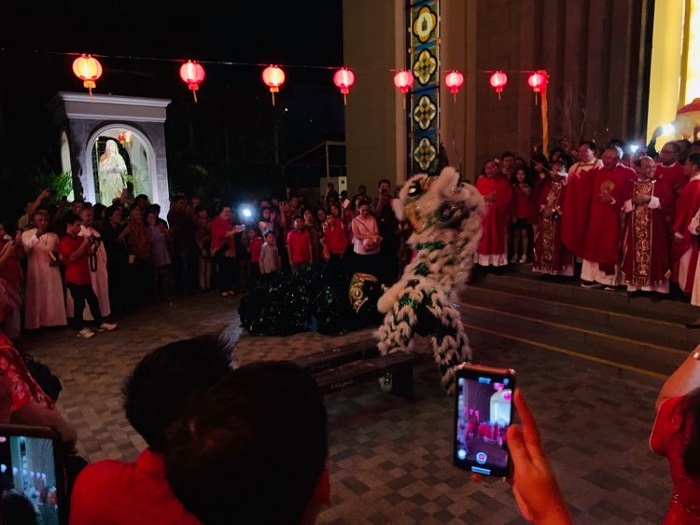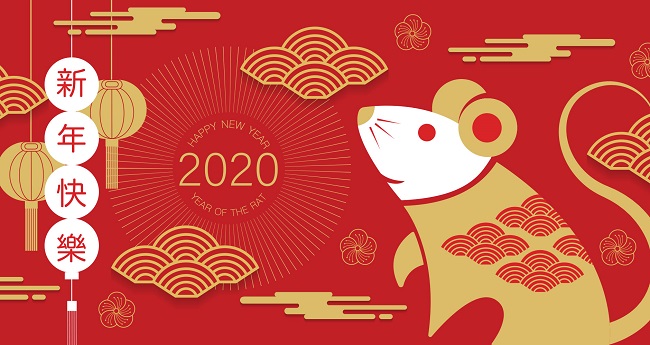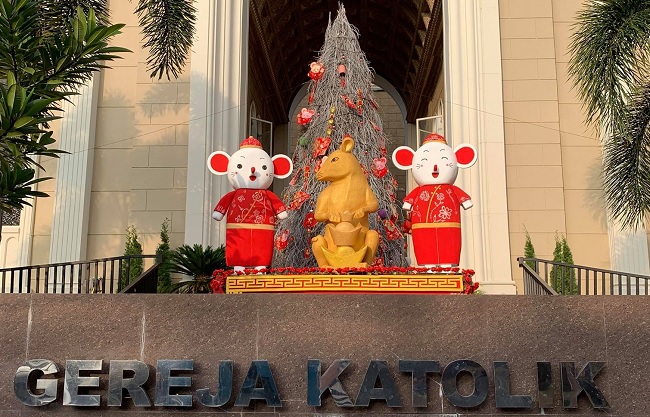Practices such as Imlek masses are a welcome example of tolerance and plurality
Josh Stenberg
Strolling about Manado in between bouts of writing and translation this past January, I’m keeping a lazy watch for the public manifestations of Chinese New Year on the streets. Partly because I’ve experienced Chinese New Year on Java and Borneo, but never on Sulawesi, and am curious about any differences. And partly because I won’t be having any festivities of my own this year, being away both from my family and friends.
In front of Manado’s principal klenteng, Ban Hin Kiong (Palace of the Ten Thousand Flourishings), clusters of young women in jilbab are snapping pics of one another in front of statues of the Three Kingdoms warrior god Guan Gong or among the plastic plum trees, a traditional symbol of resilience through the cold winter. The plum tree is also a symbol of the triumph of narrative over climate when they appear, as they are here, in the tropics. They are an imagined end to an imagined season. It is 6pm Indonesia Central Standard Time on the first day of the Year of the Rat.
A few blocks away, Fr Terry Ponomban is stressing a message of resilience to his congregation at the Saint Ignatius Catholic Church, standing at his dais before a number of other plastic plum trees. These are set underneath the stained glass in the chancel and are festooned with angpao red envelopes, traditionally the Chinese New Year money gifts. Lucky mandarin oranges are handed to latecomers. More angpao are being distributed in the crowd embossed with the words “Happy New Year” in Chinese characters and a reference to scripture on a slip of paper.
Four red lanterns hang behind the altar and open Chinese fans are strung decoratively against the walls, between stations of the cross and on statuary pedestals. Some Imlek masses have introduced a ‘dress code’ of red and the St. Ignatius faithful have taken this to the heart, with even the priests and the altar-serving girls in red with only the altar boys in white. Red formal outfits, blouses and polo shirts (some edged in batik, some with double-happiness roundels) are varied with a smattering of darker batik. Before the church offering bag comes around, girls danced fan-flourishing down the aisle, and later sang the ubiquitous Mandarin Imlek song, ‘Gongxi ni,’ (Congratulations) a 1945 Shanghai hit, originally written to celebrate not the Lunar New Year but the defeat of the Japanese.

Fr Terry Ponomban’s sermon begins with a quote from the Pope’s Lunar New Year greetings, urging ’all to pray also for peace, dialogue and solidarity among nations: gifts which are so necessary in the world today’ before developing the idea of Imlek as a symbol of spring and renewal into a message that materialism must not be at the centre of the new year. Prosperity and wealth, Fr Terry urges, are to be understood as spiritual goals, and tells a story of a child hiding in a gift box to show how humans are offerings to one another as well as to the church. Two nuns are called up to the stage to bear testimony, one of them of Chinese background. Fr Terry emphasises that Chinese too, can become priests and nuns, who could ‘give themselves to the church’. The message is also transmitted that Imlek is a season for thanksgiving and family time, the latter a value particularly and enthusiastically shared across Chinese and Catholic ethics.
Perhaps for this reason, various banners featuring messages such as ‘Happy New Year’ and ‘Happy New Spring’ (Xinnian kuaile/Xinchun kuaile) predominate over the ‘gongxi facai/kung hey fat choi’ type messages, which are more visible in Indonesian cities in general, but which mean ‘Congratulations on Good Fortune’ and may be thought too materialistic for the church.
Use of language in the service shows some another interesting features. Although no Chinese language is audibly spoken by members of the congregation and there is no reason to believe anyone is from China, an introduction to mass is given in Mandarin and two different priests make valiant comments in that language. The bible readings, the first of which from the Book of Genesis, are also given bilingually. The progress of Mandarin in Chinese community events, including the religious dimension, will be an interesting development to watch for some linguistic anthropologists. Santa Maria de Fatima in Glodok, Jakarta, one of the most historic Chinese churches in the country, also hosts a ‘Mandarin community’ seeking to link religious community with language acquisition (usually framed as ‘revival’).

As the red-clad choir sings the last hymn to a melody by Michael Haydn (brother of Joseph), the congregation files out of the church to be greeted by the pounding of drums. Outside, the Christmas tree presides, an enormous white plastic affair flanked by large statuary rats and further decorated with rodent-themed angpao. In front of an alcove containing a statue of the Virgin Mary, two barongsay (one black and one green), display their acrobatic prowess jumping onto and between low benches, while all and sundry, phones in hand, exclaim and take smartphone videos. Fr Terry holds a rod in his hand from which another angpao dangles, a reward for the barongsay teams to capture at the end of their routine.
Since 1998, it would seem that among Abrahamic religions it is Catholicism which has most warmly embraced Imlek. Scholars have documented debates in Indonesian Islam about Imlek, with some Chinese Muslim groups overtly observing it, others tolerating it outside of religious contexts, and others considering it haram. To judge anecdotally, Chinese Protestant congregations do not usually formally celebrate Imlek, though some families do at home. But Catholics seem to have picked up Imlek rapidly after reformasi, with scholars documenting celebrations as early as 1998. Instagram, which led me to St. Ignatius, shows images of Catholic congregations from northern Sumatra to Pontianak to Papua celebrating some version of an Imlek mass.
There is an historical dimension to the question of retaining Chineseness within Catholicism. Most famously, the Chinese rites controversy raged in the 17th and 18th century, when Catholic missionaries in China took differing views on practices such as ancestor worship. Which Chinese practices were to be conceived of us as contrary to or incompatible with Catholic beliefs and rites? Ultimately, the Pope forbade Chinese rituals in 1704, but the question hinges on what is defined as ritual and what is ‘simply’ culture. In Indonesia in 2020, the Catholic church seems untroubled by a modicum of zodiac Rats, fan dances, and Mandarin readings.
New anxieties
The consensus would seem to be that Chinese Indonesians feel a little less secure than they did five years ago, before the Ahok and other blasphemy trials, the escalation of foreign-worker rhetoric, the Xinjiang camps, and the coronavirus pandemic, all of which have unsettled euphoric narratives. Practices such as Imlek masses, however, are a welcome reminder that the bedrock of belief and ethnicity in Indonesia has historically been tolerant, plural, and syncretic.
The slip in my angpao instructs me to turn the bible in the pew open to Amos 5:14, which begins “Seek good, not evil, and ye may live.’ Amos was a minor and rather severe prophet, but the quote is still the kind of sentiment to which one can only hopefully say, Amin, Amen, 阿門. (And Happy Year of the Rat).
Josh Stenberg is a lecturer in the Department of Chinese Studies at The University of Sydney.
